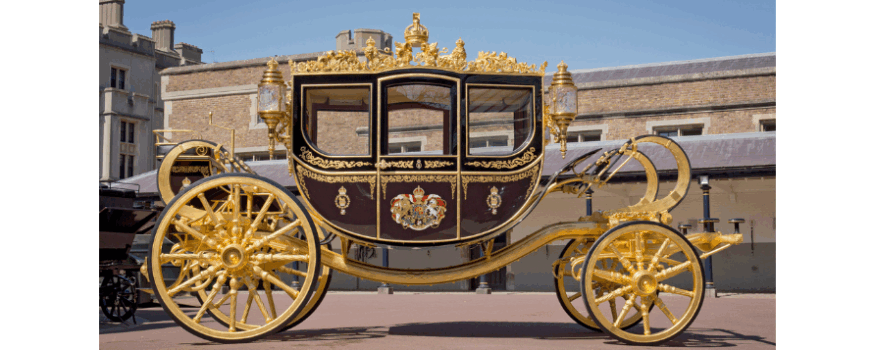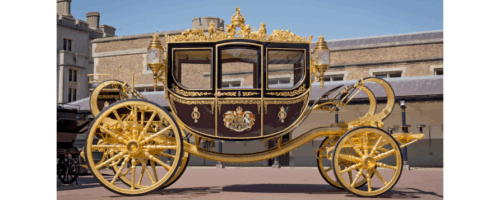© Royal Collection Enterprises Limited 2025
The Royal Mews at Buckingham Palace, is celebrating its 200th anniversary this month.
Home to the historic coaches and carriages used by the Royal Family, including the Gold State Coach used at the Coronation, the Royal Mews has played a major part in every coronation and royal wedding since it was built. Open to the public, it gives visitors a behind-the-scenes insight into these royal events.
From housing a school for the children of Buckingham Palace staff during Queen Victoria’s reign, to being bombed during the Second World War, and as a living community to this day described by Queen Elizabeth II as a ‘small village which belongs to Buckingham Palace’, the Royal Mews has played an important role in London and the nation’s history.
The Royal Mews was built in 1825 for George IV and designed by the architect John Nash, who was charged with turning Buckingham House into a palace. For a cost of over £65,000, Nash built grand stables for 100 horses. Prior to this, the Mews had been located at Charing Cross, on the present site of the National Gallery, an institution also celebrating its 200th anniversary this year.
The name ‘Mews’ comes from the royal hawks that were originally kept at the King’s Mews. The word ‘mew’ means moulting, and the birds were kept in a ‘mews’ as they weren’t used for hunting whilst their feathers moulted. The building at Charing Cross housing the original Mews was rebuilt as stables but kept the name ‘Mews’ even though it had a different function.
In 1848, Queen Victoria recorded in her journal that she had been visiting the Mews at Buckingham Palace to watch daguerreotypes (an early form of photograph) being created. She wrote: “…went to the stables to see the horses daguerotyped, which really was curious, particularly to see how badly the horses placed themselves, when they had to stand still.”
The Mews was, and still is, a living community – with generations of Palace staff and their families living on site. In 1855, Queen Victoria set up a school for the children of families who worked at the Palace and the Mews. Classes were conducted in two small rooms, where children were “carefully taught, and passed their examination very creditably”, as per an inspector’s report from the 1870s.
During the First World War in 1916, King George V and Queen Mary hosted a tea party for wounded soldiers at the Mews. Queen Mary described how “they had tea first in the Coach Houses, members of our family presiding at each table, & being helped by the ladies & gentlemen of our household, & various friends of ours” and “the entertainments consisted of various artistes, acrobats, conjurers etc., an excellent choir singing songs of which the men knew the choruses, & sang them most lustily”.
During the Second World War, the horses and carriages were sent away from the Mews for safety, and the Gold State Coach was moved out of London to Mentmore Towers in Buckinghamshire. The Mews suffered damage from the bomb that destroyed the chapel beside Buckingham Palace, the site of which later became The King’s Gallery.
The Royal Mews has been open to the public in some form throughout its 200-year history, with the first mention of people applying to visit in 1852 and the first visitors purchasing official tickets just before the Second World War. In the months before the Coronation of Queen Elizabeth II in 1953, the Mews became a popular visitor attraction, receiving up to 1,500 visitors daily as the event approached.
The highlight of a visit to the Royal Mews is the Gold State Coach, which has been used at every coronation since William IV and was most recently used at the King’s Coronation in 2023. It was used by Queen Elizabeth II on her Coronation Day in 1953 to travel between Buckingham Palace and Westminster Abbey, when Royal Mews staff strapped a hot water bottle under the seat, as the day was unseasonably cold and wet.
Today, the Mews welcomes hundreds of thousands of visitors each year and provides a unique opportunity to go behind the scenes and see the work of the Royal Household department that provides road transport for The King and members of the Royal Family. As well as the historic carriages, the Mews is home to more modern coaches, including the Diamond Jubilee State Coach, which was first used in 2014 and incorporates items relating to significant events in British history, from a musket ball from the Battle of Waterloo to a piece of a Battle of Britain Spitfire.
Visitors can often witness the daily work of the Royal Mews staff, from feeding, exercising, mucking out, and training the Windsor Grey and Cleveland Bay horses that pull the royal carriages to the work that takes place in the harness room throughout the day. They may also see the messenger Brougham carriage that sets out daily from the Mews to transfer the post between royal residences, a task that has taken place since 1843.
The Mews offers a range of interactive displays and activities for visiting families. In the State Stables, children can dress up as coachmen, tackle the challenge of tacking up a wooden pony, and have their photograph taken sitting inside a model carriage. The free family multimedia guide includes games, videos and fun facts, offering children an interactive journey through the royal cars, horses, and carriages at the Mews.
Guided tours take place daily, with special family tours taking place on some weekends, and a varied programme of free activities is available for children during school holidays. This May half-term, families can celebrate the anniversary with special art activities, giving children the chance to decorate a sparkly silver or gold crown and a miniature wooden carriage to take home as mementos of this historic occasion. Concessions including half price tickets for children aged 5 – 17 are available, with those under 5 going free.
This summer, visitors can also choose a Royal Day Out ticket, giving access to the Royal Mews, The Edwardians: Age of Elegance exhibition at The King’s Gallery, and the State Rooms at Buckingham Palace.
Click here to find out more about the Royal Collection Trust.










